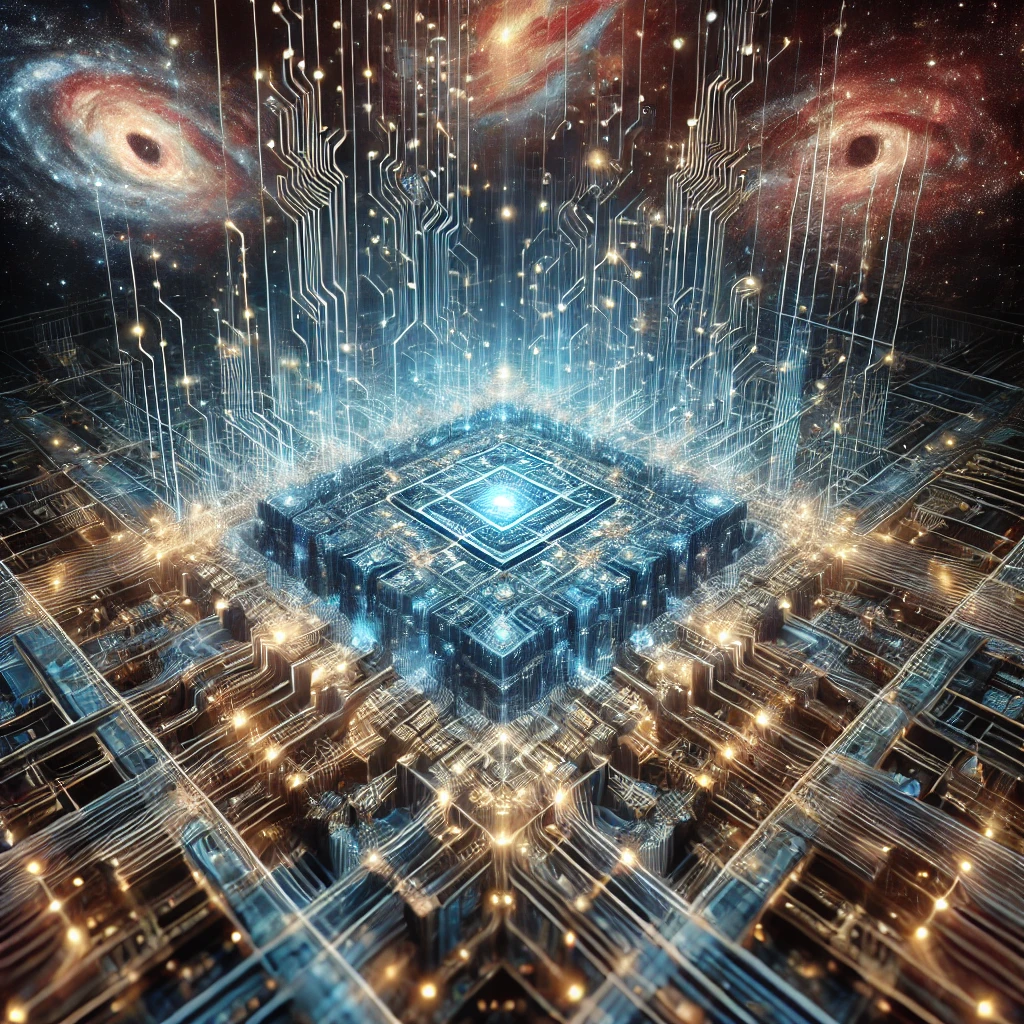Your cart is currently empty!

Generator Of Dimensions (G.O.D.)
A Thought Experiment Connecting the Interdimensional Nature of Reality to our Everyday Experience
The universe is a complex system that can be most thoroughly understood through metaphors. Imagine the universe as a system—an interdimensional clock or computer. Within this system, we, as humans, act as logic gates on a vast interdimensional motherboard, exploring and understanding our surroundings in ways that stretch beyond the limits of our current scientific understanding. My goal here is to explore a worldview that uses concepts from various scientific and philosophical sources to provide a unified understanding of the universe’s interconnected nature and our role within it.
What Do We Mean by “Interdimensional”?
In this context, interdimensional refers to multiple layers of existence beyond the familiar three-dimensional space and time. These layers could transcend our immediate perception and allow us to imagine how the universe might function beyond the limits of what we can directly observe. Though the presence of higher dimensions remain theoretical, they provide a powerful metaphor for the information in our environment beyond our comprehension.
The Universe as an Interdimensional Computer
Digital Physics: The Universe as a Computational System
The idea of the universe as an “interdimensional computer” refers to the notion that it operates with precise, systematic processes, much like a finely tuned machine or a vast computational system. This metaphor draws inspiration from the theory of digital physics, which posits that the universe functions similarly to a quantum computer, continuously processing information. In “Programming the Universe,” quantum computer scientist Seth Lloyd explores the idea that the universe processes and transmits data according to specific, mathematical rules—much like how a computer operates according to its programming.
If we extend this concept to human cognition and communication, we see that the way humans define and categorize information mirrors this same systematic process. Just as particles and forces in the universe interact according to established rules, humans interact with their environment by interpreting, organizing, and categorizing information. When we learn something new, our brains act as logic gates—taking in input, processing it according to previously learned patterns, and producing an output in the form of understanding or action. This is an individualized expression of the universe’s grand information-processing system.
Communication as a Reflection of the Universal System
When we communicate this information to others, whether through speech, writing, or action, we transmit processed data in a way that mirrors the flow of information through a computational system. Our words and actions serve as the logical outcomes of the inputs we have received and the processing our brains have performed. When another person receives that information, they too act as logic gates, interpreting and processing the input within the context of their own understanding.
This exchange of information is not isolated—it accumulates in the collective consciousness, much like how individual processors in a vast network contribute to the overall functioning of a larger system. Each individual contributes to the shaping of collective knowledge by defining and categorizing their understanding of the world, then communicating it to others. This process feeds back into the collective understanding, reinforcing or altering the categories and definitions used by the broader society.
Think of how, when we share new ideas or insights with others, we refine our thoughts through conversation. Each person processes the shared information, applies their own perspective, and reshapes the idea in response. This dynamic flow of ideas mirrors the computational logic of a larger network.
Humans as Logic Gates on an Interdimensional Motherboard
The Role of Information in Human Existence
Just as logic gates in a computer process information and make decisions based on inputs, humans can be seen as processors within the universe’s vast computational system. The metaphor of humans as logic gates on an interdimensional motherboard is a reference to how our actions, thoughts, and experiences contribute to the processing and transmission of information within this grand system.
In “The Selfish Gene,” Richard Dawkins introduces the idea that humans, like all living beings, are vehicles for genes that seek to replicate and transmit information. While Dawkins’ focus is on genetics, this concept can be extended to the broader idea that humans are part of a larger system of information processing. Each of our interactions with the world around us contributes to the flow of information within the universe, much like logic gates in a computer contribute to the functioning of a larger program by directing the electrical signal along its path in the circuit.
Imagine how you decide what to post on social media. You gather information (input), process it through your experiences and thoughts, and then share it (output). In this way, each person acts like a logic gate, influencing how information flows through the digital world, which then influences others’ inputs.
Humans as Logic Gates in the Collective Understanding
Just as the universe processes information at a cosmic scale, humans play a crucial role in the ongoing evolution of understanding at the societal level. Each of us acts as a logic gate, constantly receiving, processing, and transmitting information. Our collective categorization of knowledge—how we define truth, organize concepts, and communicate ideas—is a direct reflection of the same logic-driven processes that govern the universe itself.
As we categorize and communicate information, we help define the framework of knowledge for others. In doing so, we contribute to the larger system that operates much like a vast interdimensional computer, steadily organizing and processing information across both individual and collective scales. The more we interact, the more this system evolves, much like a feedback loop in a complex network.
In this way, the metaphor of the universe as an interdimensional computer extends beyond the cosmos itself. It includes the human experience, our perception of reality, and our role in processing and shaping collective knowledge. Through this process, humans are not just passive participants but active contributors, mirroring the broader computational nature of the universe and reinforcing the idea that we are integral to this intricate, interconnected system.
Exploring the Multiverse as a Fourth-Dimensional Entity
Higher Dimensions and Human Perception
Thinking of humans as a single 4th-dimensional entity experiencing itself via the 3rd dimension touches on the idea that our perception of reality is limited by our dimensional constraints. In his book “Flatland,” Edwin A. Abbott explores the concept of higher dimensions through a story that illustrates how beings in lower dimensions perceive those in higher ones. For example, a 2D being living in a flat plane would have no concept of depth, just as we, living in a 3D world, have limited understanding of higher dimensions.
Beyond our role as processors within this cosmic system, our very perception of reality might be constrained by the dimensions we exist within. While the concept of higher dimensions remains largely speculative, it is a useful metaphor for understanding the limits of our perception. The idea that we might be fourth-dimensional beings experiencing a third-dimensional reality is designed to convey that our true nature extends beyond what we can perceive, and that our collective journey through life is an exploration of the boundaries of our dimensional existence. Michio Kaku, in “Hyperspace,” further explores the idea of multiple dimensions and how they might interact with our own, offering a scientific perspective that complements this metaphor.
God as Collective Human Consciousness
The Global Brain and the Divine Matrix
God as the embodiment of the central seed of collective human consciousness is an interpretation that aligns with certain spiritual and philosophical traditions. Gregg Braden’s “The Divine Matrix” explores the idea of a unified field that connects all life. This concept of a connected consciousness or higher awareness aligns with the metaphor of God as the central body to which each individual, as the cilia, feed information. In this view, each person’s life purpose is to learn, grow, and contribute to this collective consciousness, enriching the shared human experience. Similarly, Howard Bloom, in “The Global Brain,” discusses how humanity functions as a collective consciousness, where our individual thoughts and experiences contribute to a larger, shared understanding.
TL:DR
The metaphors of the universe as a clock or computer, humans as logic gates, and God as collective consciousness are not scientific truths, but they offer a creative framework for understanding the interconnectedness of existence. By drawing on ideas from digital physics, genetic theory, dimensional exploration, and collective consciousness, these metaphors provide a way to think about the universe and our place within it that stretches beyond the conventional boundaries of science and spirituality.
On a personal level, this contemplation encourages a more reflective approach to how we process, communicate, and influence the flow of information in our daily lives. Just as logic gates shape the output of a computer, our choices and interactions shape the understanding of those around us. We should always deepen our exploration of the connections between ourselves, the universe, and the collective consciousness we contribute to. In doing so, we may come closer to understanding the true nature of reality and the profound role we play within it. This could inspire us to become more mindful about how we engage with information, realizing our impact on the broader system of collective knowledge. As we explore the interconnectedness of existence, how do you see your role in this grand design of consciousness and cosmic computation?
Read More
To learn more about the philosophical foundations of this perspective, consider the following resources:
1. Digital Physics and the Universe as a Computational System
- Resource: “Programming the Universe: A Quantum Computer Scientist Takes on the Cosmos” by Seth Lloyd.
- Concept: This book explores the idea of the universe functioning like a quantum computer, which aligns with the metaphor of an interdimensional clock or computational system processing information.
2. Humans as Logic Gates/Information Processors
- Resource: “The Selfish Gene” by Richard Dawkins.
- Concept: Dawkins discusses how genes replicate and transmit information, supporting the metaphor of humans as logic gates within a larger system of information processing.
3. Fourth-Dimensional Beings and Higher Dimensions
- Resource: “Flatland: A Romance of Many Dimensions” by Edwin A. Abbott.
- Concept: Abbott’s novella explores the perception of higher dimensions, supporting the idea of humans as fourth-dimensional beings experiencing the third dimension.
- Resource: “Hyperspace: A Scientific Odyssey Through Parallel Universes, Time Warps, and the 10th Dimension” by Michio Kaku.
- Concept: Kaku explores the possibility of multiple dimensions, offering a scientific perspective on the metaphor of higher-dimensional entities.
4. Collective Consciousness and the Concept of God
- Resource: “The Global Brain: The Evolution of Mass Mind from the Big Bang to the 21st Century” by Howard Bloom.
- Concept: Bloom discusses how humanity functions as a collective consciousness, aligning with the metaphor of God as collective human consciousness.
- Resource: “The Divine Matrix: Bridging Time, Space, Miracles, and Belief” by Gregg Braden.
- Concept: Braden’s work on a unified field that connects all life supports the idea of a collective or interconnected consciousness.
5. Neural Networks and Human Consciousness
- Resource: “On Intelligence” by Jeff Hawkins.
- Concept: Hawkins explores how the human brain functions like a predictive machine, which aligns with the metaphor of humans as logic gates or processors in a cosmic network.
6. Cilia as Sensory Apparatus
- Resource: Biology Textbooks on Cell Structure and Function.
- Concept: Cilia are microscopic, hair-like structures on cells that detect environmental signals. This supports the metaphor of humans as cilia feeling out the boundaries of navigable space.

Leave a Reply